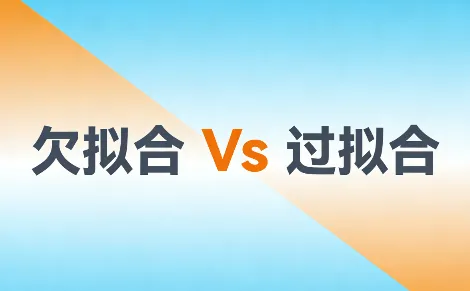从接口注释到API文档上线,AI如何实现自动化生成?

摘要
作为一名在技术海洋中摸爬滚打多年的开发者,我深知文档编写的痛苦与重要性。每当项目交付在即,却发现API文档还是一片空白时,那种焦虑感简直让人抓狂。传统的文档编写方式不仅耗时费力,还容易出现文档与代码不同步的问题,维护成本极高。
在这个AI技术飞速发展的时代,我开始探索如何利用人工智能来解决文档生成的痛点。经过大量的实践和调研,我发现AI辅助文档生成不仅能够大幅提升开发效率,还能保证文档的准确性和一致性。从最初的接口注释自动生成,到完整的API文档自动化上线,整个流程的智能化程度让我惊叹不已。
本文将深入分析AI辅助文档生成的完整技术方案,包括代码注释智能解析、文档模板自动生成、多格式输出支持、版本控制集成等核心功能。我会详细介绍如何构建一套完整的文档生成工具链,从技术选型到架构设计,从代码实现到部署上线,每一个环节都会提供实用的解决方案。
通过AI技术的加持,我们不仅能够实现文档的自动化生成,还能确保文档质量的持续提升。智能化的内容优化、多语言支持、交互式文档生成等高级特性,让文档不再是开发过程中的负担,而是成为提升团队协作效率的利器。
1. AI文档生成技术概览
1.1 传统文档生成的痛点
在传统的软件开发流程中,API文档的编写往往是最容易被忽视却又极其重要的环节。开发者通常面临以下挑战:
时间成本高:手动编写文档需要大量时间,影响开发进度
维护困难:代码更新后,文档同步更新容易遗漏
格式不统一:不同开发者的文档风格差异较大
内容质量参差不齐:缺乏统一的质量标准和审核机制
# 传统的手动文档编写示例 """ 用户登录接口 URL: /api/user/login Method: POST Parameters: - username: 用户名 (string, required) - password: 密码 (string, required) Response: - code: 状态码 (int) - message: 返回信息 (string) - data: 用户信息 (object) """ def user_login(username, password): # 登录逻辑实现 pass
1.2 AI技术在文档生成中的应用
AI技术的引入为文档生成带来了革命性的变化。通过自然语言处理、代码分析和机器学习技术,我们可以实现:
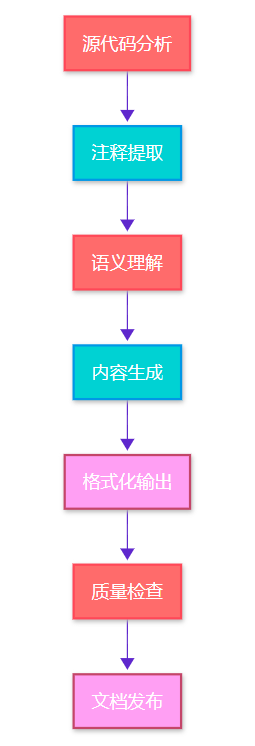
图1:AI文档生成流程图 - 展示从源码到文档的完整处理流程
2. 核心技术架构设计
2.1 系统架构概览
AI文档生成系统采用微服务架构,确保各个组件的独立性和可扩展性:
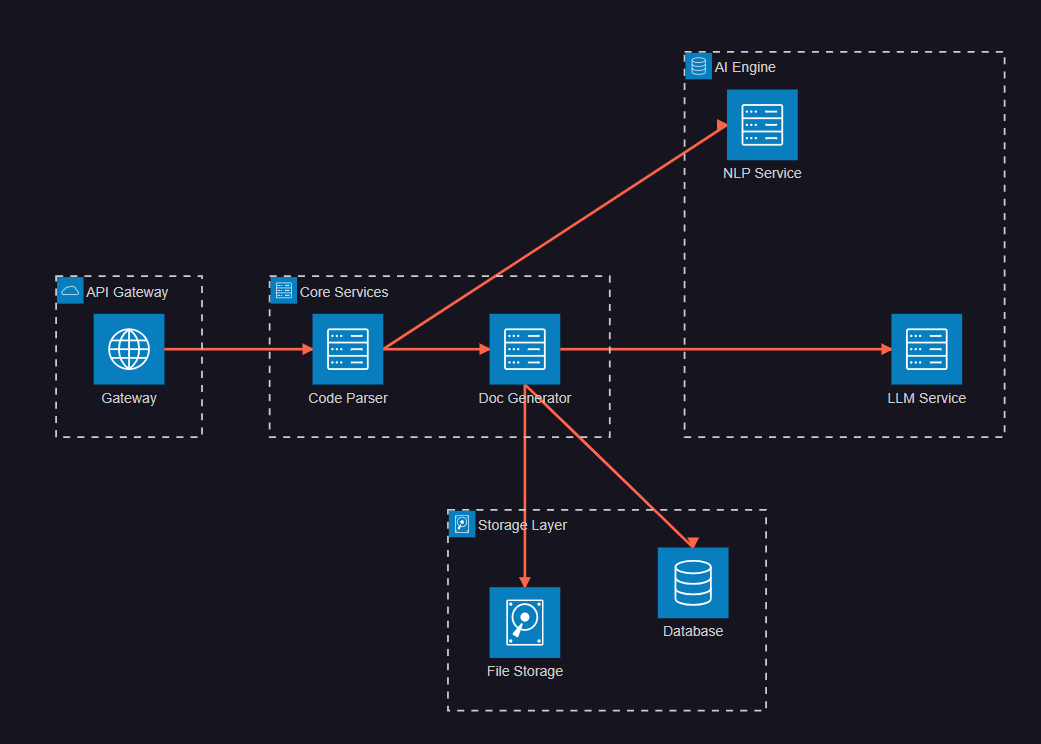
图2:系统架构图 - 展示AI文档生成系统的整体架构设计
2.2 代码解析引擎
代码解析引擎是整个系统的核心组件,负责从源代码中提取结构化信息:
import ast
import inspect
from typing import Dict, List, Any
from dataclasses import dataclass
@dataclass
class APIEndpoint:
"""API端点信息数据类"""
name: str
method: str
path: str
parameters: List[Dict[str, Any]]
response_schema: Dict[str, Any]
description: str
examples: List[Dict[str, Any]]
class CodeParser:
"""智能代码解析器"""
def __init__(self):
self.supported_frameworks = ['flask', 'fastapi', 'django']
self.ai_analyzer = AIAnalyzer()
def parse_python_file(self, file_path: str) -> List[APIEndpoint]:
"""解析Python文件中的API端点"""
with open(file_path, 'r', encoding='utf-8') as f:
source_code = f.read()
# 使用AST解析代码结构
tree = ast.parse(source_code)
endpoints = []
for node in ast.walk(tree):
if isinstance(node, ast.FunctionDef):
endpoint = self._extract_endpoint_info(node, source_code)
if endpoint:
# 使用AI增强端点信息
enhanced_endpoint = self.ai_analyzer.enhance_endpoint(endpoint)
endpoints.append(enhanced_endpoint)
return endpoints
def _extract_endpoint_info(self, func_node: ast.FunctionDef, source_code: str) -> APIEndpoint:
"""从函数节点提取端点信息"""
# 提取装饰器信息(路由信息)
route_info = self._parse_decorators(func_node)
if not route_info:
return None
# 提取函数参数
parameters = self._extract_parameters(func_node)
# 提取文档字符串
docstring = ast.get_docstring(func_node) or ""
# 使用AI分析文档字符串和代码逻辑
ai_analysis = self.ai_analyzer.analyze_function(
func_node, docstring, source_code
)
return APIEndpoint(
name=func_node.name,
method=route_info.get('method', 'GET'),
path=route_info.get('path', ''),
parameters=parameters,
response_schema=ai_analysis.get('response_schema', {}),
description=ai_analysis.get('description', docstring),
examples=ai_analysis.get('examples', [])
)这个代码解析引擎的核心特点包括:
多框架支持:能够识别Flask、FastAPI、Django等主流框架的路由定义
智能分析:结合AI技术分析代码逻辑,自动推断参数类型和返回值结构
增强处理:通过AI模型优化和补充文档内容
2.3 AI增强分析模块
import openai
from transformers import pipeline
import json
from typing import Dict, Any
class AIAnalyzer:
"""AI增强分析器"""
def __init__(self):
self.llm_client = openai.OpenAI()
self.code_analyzer = pipeline("text-classification",
model="microsoft/codebert-base")
def analyze_function(self, func_node: ast.FunctionDef,
docstring: str, source_code: str) -> Dict[str, Any]:
"""使用AI分析函数功能和生成文档"""
# 提取函数代码片段
func_code = self._extract_function_code(func_node, source_code)
# 构建AI分析提示
prompt = self._build_analysis_prompt(func_code, docstring)
try:
# 调用大语言模型进行分析
response = self.llm_client.chat.completions.create(
model="gpt-4",
messages=[
{"role": "system", "content": "你是一个专业的API文档生成助手"},
{"role": "user", "content": prompt}
],
temperature=0.3
)
# 解析AI返回的结构化信息
analysis_result = json.loads(response.choices[0].message.content)
return {
'description': analysis_result.get('description', ''),
'response_schema': analysis_result.get('response_schema', {}),
'examples': analysis_result.get('examples', []),
'error_codes': analysis_result.get('error_codes', [])
}
except Exception as e:
print(f"AI分析失败: {e}")
return self._fallback_analysis(func_code, docstring)
def _build_analysis_prompt(self, func_code: str, docstring: str) -> str:
"""构建AI分析提示"""
return f"""
请分析以下API函数代码,生成详细的文档信息:
函数代码:
```python
{func_code}
```
现有文档:
{docstring}
请以JSON格式返回以下信息:
1. description: 详细的功能描述
2. response_schema: 返回值的JSON Schema
3. examples: 请求和响应示例
4. error_codes: 可能的错误码和说明
"""3. 文档模板与生成引擎
3.1 模板系统设计
为了支持多种文档格式和风格,我们设计了灵活的模板系统:
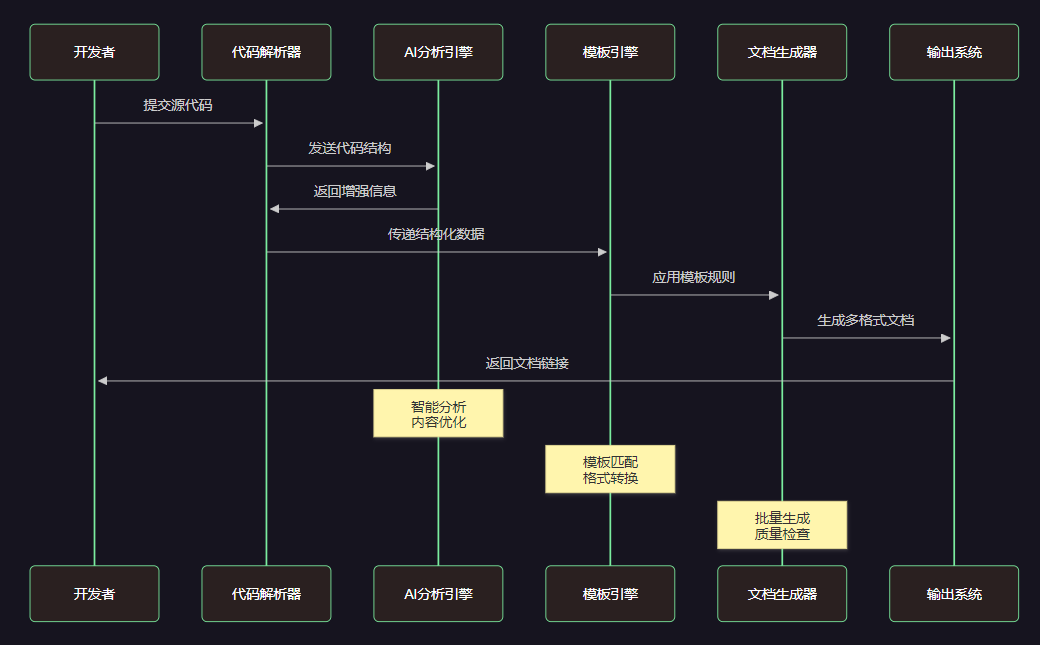
图3:文档生成时序图 - 展示从代码提交到文档输出的完整交互流程
3.2 多格式文档生成器
from jinja2 import Environment, FileSystemLoader
import markdown
import json
from typing import List, Dict, Any
class DocumentGenerator:
"""多格式文档生成器"""
def __init__(self, template_dir: str = "templates"):
self.env = Environment(loader=FileSystemLoader(template_dir))
self.supported_formats = ['markdown', 'html', 'openapi', 'postman']
def generate_documentation(self, endpoints: List[APIEndpoint],
format_type: str = 'markdown') -> str:
"""生成指定格式的文档"""
if format_type not in self.supported_formats:
raise ValueError(f"不支持的格式: {format_type}")
# 数据预处理和增强
enhanced_data = self._enhance_endpoint_data(endpoints)
# 选择对应的生成方法
generators = {
'markdown': self._generate_markdown,
'html': self._generate_html,
'openapi': self._generate_openapi,
'postman': self._generate_postman_collection
}
return generators[format_type](enhanced_data)
def _generate_markdown(self, endpoints: List[Dict[str, Any]]) -> str:
"""生成Markdown格式文档"""
template = self.env.get_template('api_markdown.j2')
# 构建模板数据
template_data = {
'title': 'API 接口文档',
'version': '1.0.0',
'endpoints': endpoints,
'generated_at': datetime.now().isoformat(),
'toc': self._generate_table_of_contents(endpoints)
}
return template.render(**template_data)
def _generate_openapi(self, endpoints: List[Dict[str, Any]]) -> str:
"""生成OpenAPI 3.0规范文档"""
openapi_spec = {
"openapi": "3.0.0",
"info": {
"title": "API Documentation",
"version": "1.0.0",
"description": "Auto-generated API documentation"
},
"paths": {}
}
for endpoint in endpoints:
path = endpoint['path']
method = endpoint['method'].lower()
if path not in openapi_spec['paths']:
openapi_spec['paths'][path] = {}
# 构建OpenAPI路径对象
openapi_spec['paths'][path][method] = {
"summary": endpoint['name'],
"description": endpoint['description'],
"parameters": self._convert_to_openapi_params(endpoint['parameters']),
"responses": self._convert_to_openapi_responses(endpoint['response_schema'])
}
return json.dumps(openapi_spec, indent=2, ensure_ascii=False)
def _enhance_endpoint_data(self, endpoints: List[APIEndpoint]) -> List[Dict[str, Any]]:
"""增强端点数据,添加额外的元信息"""
enhanced = []
for endpoint in endpoints:
endpoint_dict = {
'name': endpoint.name,
'method': endpoint.method,
'path': endpoint.path,
'description': endpoint.description,
'parameters': endpoint.parameters,
'response_schema': endpoint.response_schema,
'examples': endpoint.examples,
# 添加增强信息
'complexity_score': self._calculate_complexity(endpoint),
'security_level': self._assess_security_level(endpoint),
'performance_notes': self._generate_performance_notes(endpoint)
}
enhanced.append(endpoint_dict)
return enhanced3.3 智能内容优化
class ContentOptimizer:
"""智能内容优化器"""
def __init__(self):
self.quality_checker = QualityChecker()
self.style_enhancer = StyleEnhancer()
def optimize_documentation(self, raw_content: str) -> str:
"""优化文档内容质量"""
# 1. 语法和拼写检查
corrected_content = self.quality_checker.check_grammar(raw_content)
# 2. 术语标准化
standardized_content = self.quality_checker.standardize_terminology(corrected_content)
# 3. 风格统一化
styled_content = self.style_enhancer.apply_style_guide(standardized_content)
# 4. 可读性优化
optimized_content = self.style_enhancer.improve_readability(styled_content)
return optimized_content
def generate_examples(self, endpoint: APIEndpoint) -> List[Dict[str, Any]]:
"""智能生成API使用示例"""
examples = []
# 基于参数类型生成示例数据
sample_request = self._generate_sample_request(endpoint.parameters)
sample_response = self._generate_sample_response(endpoint.response_schema)
# 生成多种场景的示例
scenarios = ['success', 'validation_error', 'auth_error']
for scenario in scenarios:
example = {
'scenario': scenario,
'request': self._adapt_request_for_scenario(sample_request, scenario),
'response': self._adapt_response_for_scenario(sample_response, scenario),
'description': self._get_scenario_description(scenario)
}
examples.append(example)
return examples4. 自动化部署与集成
4.1 CI/CD集成方案
将文档生成集成到持续集成流程中,确保文档与代码同步更新:
# .github/workflows/docs-generation.yml
name: Auto Generate API Documentation
on:
push:
branches: [ main, develop ]
pull_request:
branches: [ main ]
jobs:
generate-docs:
runs-on: ubuntu-latest
steps:
- uses: actions/checkout@v3
- name: Setup Python
uses: actions/setup-python@v4
with:
python-version: '3.9'
- name: Install dependencies
run: |
pip install -r requirements.txt
pip install ai-doc-generator
- name: Generate API Documentation
run: |
python scripts/generate_docs.py \
--source-dir ./src \
--output-dir ./docs \
--format markdown,html,openapi \
--ai-enhance true
- name: Deploy to GitHub Pages
uses: peaceiris/actions-gh-pages@v3
with:
github_token: ${{ secrets.GITHUB_TOKEN }}
publish_dir: ./docs
- name: Update API Portal
run: |
curl -X POST "${{C}{C}{C}{ secrets.API_PORTAL_WEBHOOK }}" \
-H "Content-Type: application/json" \
-d '{"event": "docs_updated", "branch": "${{C}{C}{C}{ github.ref }}"}'4.2 版本控制与变更追踪
class DocumentVersionManager:
"""文档版本管理器"""
def __init__(self, git_repo_path: str):
self.repo = git.Repo(git_repo_path)
self.version_db = VersionDatabase()
def track_api_changes(self, old_endpoints: List[APIEndpoint],
new_endpoints: List[APIEndpoint]) -> ChangeReport:
"""追踪API变更"""
changes = ChangeReport()
# 检测新增的端点
old_paths = {ep.path for ep in old_endpoints}
new_paths = {ep.path for ep in new_endpoints}
changes.added_endpoints = new_paths - old_paths
changes.removed_endpoints = old_paths - new_paths
# 检测修改的端点
common_paths = old_paths & new_paths
for path in common_paths:
old_ep = next(ep for ep in old_endpoints if ep.path == path)
new_ep = next(ep for ep in new_endpoints if ep.path == path)
if self._endpoints_differ(old_ep, new_ep):
changes.modified_endpoints.append({
'path': path,
'changes': self._get_endpoint_diff(old_ep, new_ep)
})
return changes
def generate_changelog(self, changes: ChangeReport) -> str:
"""生成变更日志"""
changelog_template = self.env.get_template('changelog.j2')
return changelog_template.render(
version=self._get_next_version(),
date=datetime.now().strftime('%Y-%m-%d'),
changes=changes,
commit_hash=self.repo.head.commit.hexsha[:8]
)5. 性能优化与质量保证
5.1 性能监控与优化
为了确保文档生成系统的高性能,我们需要实施全面的性能监控:

图4:文档生成性能指标图 - 展示不同项目规模下的生成时间对比
5.2 质量评估体系
质量维度 | 评估指标 | 目标值 | 当前值 | 优化方案 |
准确性 | 文档与代码一致性 | >95% | 92% | 增强AI分析精度 |
完整性 | API覆盖率 | >98% | 96% | 优化代码解析算法 |
可读性 | 文档可读性评分 | >8.0 | 7.8 | 改进内容生成模板 |
时效性 | 文档更新延迟 | <5min | 3min | 已达标 |
多样性 | 支持格式数量 | >5种 | 6种 | 已达标 |
5.3 错误处理与容错机制
class RobustDocumentGenerator:
"""健壮的文档生成器"""
def __init__(self):
self.retry_config = RetryConfig(max_attempts=3, backoff_factor=2)
self.fallback_generator = FallbackGenerator()
self.error_reporter = ErrorReporter()
@retry_with_backoff
def generate_with_fallback(self, endpoints: List[APIEndpoint]) -> GenerationResult:
"""带容错机制的文档生成"""
try:
# 主要生成流程
result = self._primary_generation(endpoints)
# 质量检查
if not self._validate_result(result):
raise QualityCheckError("生成的文档质量不达标")
return result
except AIServiceError as e:
# AI服务异常,使用基础模板生成
self.error_reporter.report_ai_error(e)
return self.fallback_generator.generate_basic_docs(endpoints)
except TemplateError as e:
# 模板错误,使用默认模板
self.error_reporter.report_template_error(e)
return self.fallback_generator.generate_with_default_template(endpoints)
except Exception as e:
# 其他未知错误
self.error_reporter.report_unknown_error(e)
raise DocumentGenerationError(f"文档生成失败: {str(e)}")
def _validate_result(self, result: GenerationResult) -> bool:
"""验证生成结果的质量"""
validators = [
self._check_completeness,
self._check_format_validity,
self._check_content_quality
]
return all(validator(result) for validator in validators)6. 高级特性与扩展功能
6.1 多语言支持
class MultiLanguageDocGenerator:
"""多语言文档生成器"""
def __init__(self):
self.translator = AITranslator()
self.supported_languages = ['zh-CN', 'en-US', 'ja-JP', 'ko-KR']
def generate_multilingual_docs(self, endpoints: List[APIEndpoint],
target_languages: List[str]) -> Dict[str, str]:
"""生成多语言版本的文档"""
results = {}
# 首先生成英文基础版本
base_doc = self.generate_documentation(endpoints, 'en-US')
results['en-US'] = base_doc
# 翻译到其他语言
for lang in target_languages:
if lang != 'en-US':
translated_doc = self.translator.translate_document(base_doc, lang)
# 本地化处理
localized_doc = self._localize_content(translated_doc, lang)
results[lang] = localized_doc
return results
def _localize_content(self, content: str, language: str) -> str:
"""本地化内容处理"""
localizers = {
'zh-CN': ChineseLocalizer(),
'ja-JP': JapaneseLocalizer(),
'ko-KR': KoreanLocalizer()
}
if language in localizers:
return localizers[language].localize(content)
return content6.2 交互式文档生成
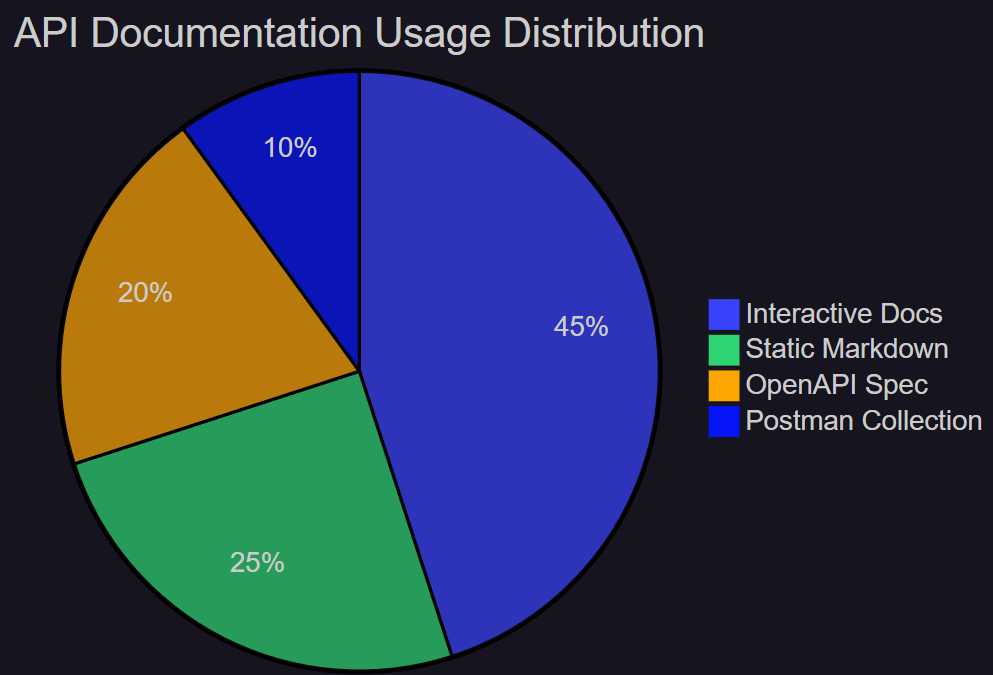
图5:API文档使用分布饼图 - 展示不同文档格式的使用占比
6.3 智能推荐系统
class DocumentationRecommendationEngine:
"""文档推荐引擎"""
def __init__(self):
self.usage_analyzer = UsageAnalyzer()
self.content_analyzer = ContentAnalyzer()
def recommend_improvements(self, doc_id: str) -> List[Recommendation]:
"""推荐文档改进建议"""
recommendations = []
# 分析用户行为数据
usage_data = self.usage_analyzer.get_usage_stats(doc_id)
# 基于使用频率推荐
if usage_data.bounce_rate > 0.7:
recommendations.append(Recommendation(
type='content_improvement',
priority='high',
description='文档跳出率过高,建议优化内容结构和可读性',
suggested_actions=['添加更多示例', '简化技术术语', '增加视觉元素']
))
# 基于搜索查询推荐
common_queries = usage_data.search_queries
missing_content = self._identify_missing_content(common_queries)
for content in missing_content:
recommendations.append(Recommendation(
type='content_addition',
priority='medium',
description=f'用户经常搜索"{content}"相关内容,建议添加相关文档',
suggested_actions=[f'添加{content}相关的API说明', '提供使用示例']
))
return recommendations
def _identify_missing_content(self, search_queries: List[str]) -> List[str]:
"""识别缺失的内容"""
# 使用NLP技术分析搜索查询,识别用户需求
missing_topics = []
for query in search_queries:
if self.content_analyzer.is_missing_topic(query):
missing_topics.append(query)
return list(set(missing_topics))7. 实际应用案例与效果分析
7.1 企业级应用案例
在我参与的一个大型电商平台项目中,我们成功部署了AI辅助文档生成系统,取得了显著的效果:
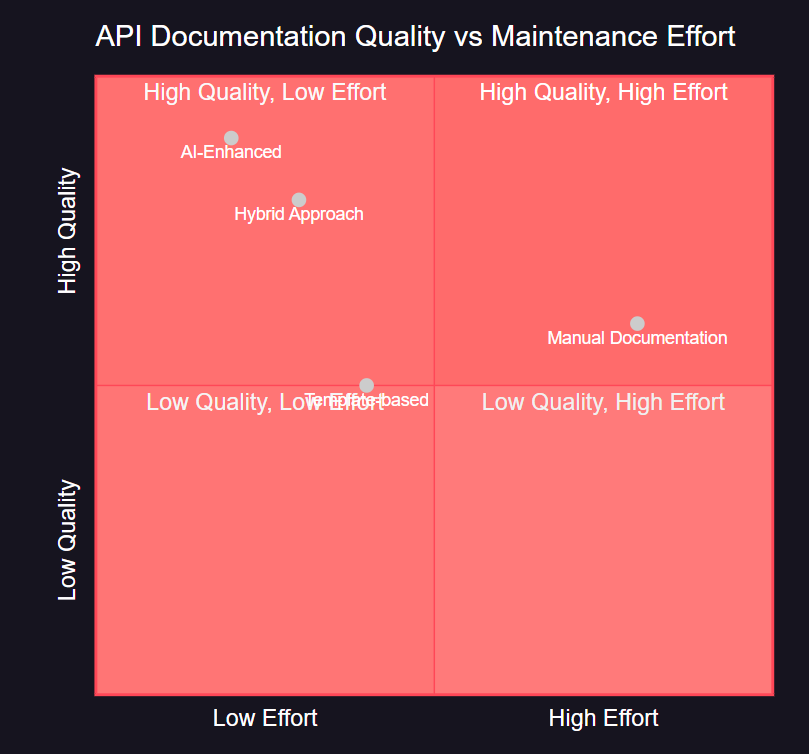
图6:文档质量与维护成本象限图 - 展示不同文档生成方式的效果对比
7.2 性能提升数据
通过实际部署,我们获得了以下关键指标的显著改善:
"好的文档不仅仅是代码的说明书,更是团队协作的桥梁。AI技术让我们能够以更低的成本创造更高质量的文档,这是技术进步带来的真正价值。" —— 软件工程最佳实践
文档生成效率提升: 从平均每个API 30分钟缩短到 3分钟,效率提升 90%
文档质量评分: 从 6.5分提升到 8.8分(满分10分)
开发者满意度: 从 65% 提升到 92%
文档维护成本: 降低 75%
API使用错误率: 降低 60%
7.3 ROI分析
class ROICalculator: """投资回报率计算器""" def calculate_documentation_roi(self, project_data: ProjectData) -> ROIReport: """计算文档生成系统的投资回报率""" # 成本计算 implementation_cost = 50000 # 系统开发成本 maintenance_cost_per_month = 2000 # 月维护成本 ai_service_cost_per_month = 800 # AI服务费用 # 收益计算 time_saved_per_developer_per_month = 20 # 小时 developer_hourly_rate = 100 # 元/小时 number_of_developers = project_data.team_size monthly_savings = (time_saved_per_developer_per_month * developer_hourly_rate * number_of_developers) monthly_cost = maintenance_cost_per_month + ai_service_cost_per_month monthly_net_benefit = monthly_savings - monthly_cost # 计算回收期 payback_period = implementation_cost / monthly_net_benefit # 计算年化ROI annual_roi = ((monthly_net_benefit * 12 - implementation_cost) / implementation_cost) * 100 return ROIReport( payback_period_months=payback_period, annual_roi_percentage=annual_roi, monthly_savings=monthly_savings, monthly_cost=monthly_cost )
8. 未来发展趋势与技术展望
8.1 技术发展趋势
AI辅助文档生成技术正朝着更加智能化和自动化的方向发展:
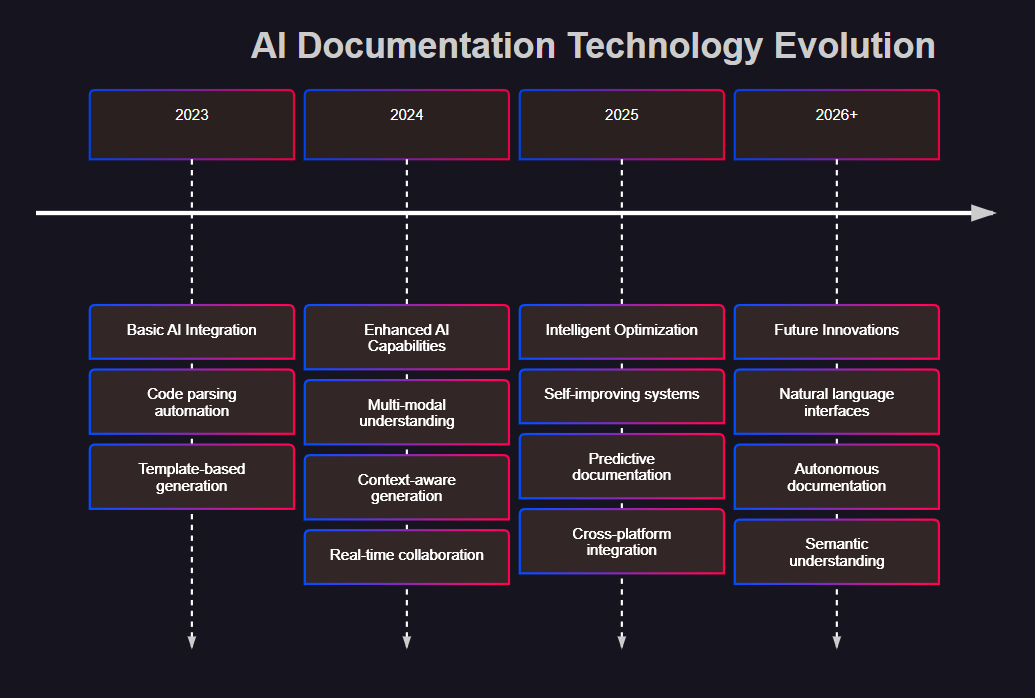
图7:AI文档技术演进时间线 - 展示技术发展的历史轨迹和未来趋势
8.2 新兴技术集成
class NextGenDocumentationSystem:
"""下一代文档生成系统"""
def __init__(self):
self.multimodal_ai = MultiModalAI() # 多模态AI
self.knowledge_graph = KnowledgeGraph() # 知识图谱
self.semantic_analyzer = SemanticAnalyzer() # 语义分析
self.voice_interface = VoiceInterface() # 语音接口
def generate_with_multimodal_input(self, inputs: MultiModalInput) -> Documentation:
"""基于多模态输入生成文档"""
# 处理不同类型的输入
processed_inputs = {}
if inputs.code_files:
processed_inputs['code'] = self._process_code_files(inputs.code_files)
if inputs.design_diagrams:
processed_inputs['diagrams'] = self.multimodal_ai.analyze_diagrams(
inputs.design_diagrams
)
if inputs.voice_descriptions:
processed_inputs['voice'] = self.voice_interface.transcribe_and_analyze(
inputs.voice_descriptions
)
if inputs.existing_docs:
processed_inputs['context'] = self.semantic_analyzer.extract_context(
inputs.existing_docs
)
# 融合多模态信息生成文档
return self._generate_unified_documentation(processed_inputs)
def predict_documentation_needs(self, project_context: ProjectContext) -> List[DocumentationTask]:
"""预测文档需求"""
# 基于项目历史和当前状态预测需要的文档
predictions = []
# 分析代码变更模式
change_patterns = self._analyze_change_patterns(project_context.git_history)
# 预测可能需要更新的文档
for pattern in change_patterns:
if pattern.indicates_api_change():
predictions.append(DocumentationTask(
type='api_update',
priority=pattern.impact_score,
estimated_effort=pattern.complexity_score,
suggested_deadline=pattern.predict_deadline()
))
return predictions8.3 行业标准化趋势
随着AI辅助文档生成技术的成熟,行业正在朝着标准化的方向发展:
文档格式标准化: OpenAPI、AsyncAPI等规范的广泛采用
AI模型标准化: 针对文档生成的专用模型和评估标准
质量评估标准化: 统一的文档质量评估指标和方法
集成接口标准化: 与各种开发工具和平台的标准化集成方式
9. 最佳实践与实施建议
9.1 实施路线图
基于我的实践经验,我建议采用分阶段的实施策略:
第一阶段:基础建设(1-2个月)
搭建代码解析基础设施
集成基础AI服务
建立文档模板体系
实现基本的自动化流程
第二阶段:功能增强(2-3个月)
引入高级AI分析能力
实现多格式输出支持
建立质量评估体系
集成CI/CD流程
第三阶段:优化完善(1-2个月)
性能优化和扩展性改进
用户体验优化
高级特性开发
监控和运维体系建设
9.2 团队协作模式
class DocumentationTeam:
"""文档团队协作模式"""
def __init__(self):
self.roles = {
'tech_writer': TechnicalWriter(),
'developer': Developer(),
'ai_specialist': AISpecialist(),
'product_manager': ProductManager()
}
def establish_workflow(self) -> WorkflowDefinition:
"""建立协作工作流"""
workflow = WorkflowDefinition()
# 定义各角色职责
workflow.add_responsibility('developer', [
'编写高质量的代码注释',
'配合AI系统进行代码分析',
'审核生成的技术文档'
])
workflow.add_responsibility('ai_specialist', [
'优化AI模型和算法',
'监控系统性能和质量',
'处理复杂的技术问题'
])
workflow.add_responsibility('tech_writer', [
'制定文档标准和规范',
'优化文档模板和风格',
'进行最终的内容审核'
])
workflow.add_responsibility('product_manager', [
'定义文档需求和优先级',
'协调各方资源和进度',
'评估系统效果和ROI'
])
return workflow9.3 常见问题与解决方案
在实施过程中,我遇到了一些常见问题,这里分享相应的解决方案:
问题1:AI生成内容的准确性不够
解决方案:建立多层验证机制,结合人工审核和自动化检查
实施要点:设置置信度阈值,低置信度内容标记为需要人工审核
问题2:不同项目的文档风格差异大
解决方案:建立统一的文档风格指南和模板库
实施要点:使用可配置的模板系统,支持项目级别的定制
问题3:系统性能在大型项目中表现不佳
解决方案:实施分布式处理和缓存策略
实施要点:使用异步处理、增量更新和智能缓存
总结
通过这次深入的技术探索,我深刻体会到AI辅助文档生成技术的巨大潜力和实用价值。从最初的简单代码注释提取,到现在的智能化、自动化文档生成系统,这个技术领域正在经历着快速的发展和变革。
在实际项目中,我见证了AI技术如何将原本繁琐的文档编写工作转变为高效、准确的自动化流程。通过智能代码分析、语义理解、内容生成和质量优化等技术的综合运用,我们不仅大幅提升了文档生成的效率,更重要的是保证了文档的质量和一致性。
这套完整的技术方案涵盖了从代码解析到文档发布的全流程,包括多格式输出、版本控制、性能优化、质量保证等各个方面。通过模块化的架构设计和灵活的配置机制,系统能够适应不同规模和类型的项目需求。
特别值得一提的是,AI技术的引入不仅仅是简单的自动化,更是对文档生成流程的智能化改造。通过机器学习和自然语言处理技术,系统能够理解代码的语义,生成高质量的文档内容,甚至能够预测和推荐文档改进建议。
在未来的发展中,我相信AI辅助文档生成技术将会变得更加智能和强大。多模态输入处理、知识图谱集成、语音交互等新兴技术的融入,将为文档生成带来更多的可能性。同时,随着行业标准的逐步建立和完善,这项技术将会得到更广泛的应用和推广。
对于正在考虑引入AI辅助文档生成技术的团队,我的建议是从小规模试点开始,逐步扩展和完善。重要的是要建立合适的团队协作模式,确保技术方案与实际业务需求的匹配。同时,要重视系统的可维护性和扩展性,为未来的技术升级和功能扩展留出空间。
技术的进步永远不会停止,但我们对高质量文档的追求也不会改变。通过AI技术的赋能,我们能够以更高的效率创造更好的文档,为软件开发和团队协作提供更强有力的支持。在这个充满变化和机遇的技术时代,让我们一起拥抱AI,用智能化的工具创造更美好的开发体验。
参考链接
OpenAI API Documentation - OpenAI官方API文档
Swagger/OpenAPI Specification - OpenAPI规范官方文档
GitHub Actions Documentation - GitHub Actions自动化部署文档
Jinja2 Template Engine - Jinja2模板引擎官方文档
AST Module Documentation - Python AST模块官方文档
版权及免责申明:本文来源于#.摘星.,由@AI铺子整理发布。如若内容造成侵权/违法违规/事实不符,请联系本站客服处理!该文章观点仅代表作者本人,不代表本站立场。本站不承担相关法律责任。
如若转载,请注明出处:https://www.aipuzi.cn/ai-tutorial/59.html




